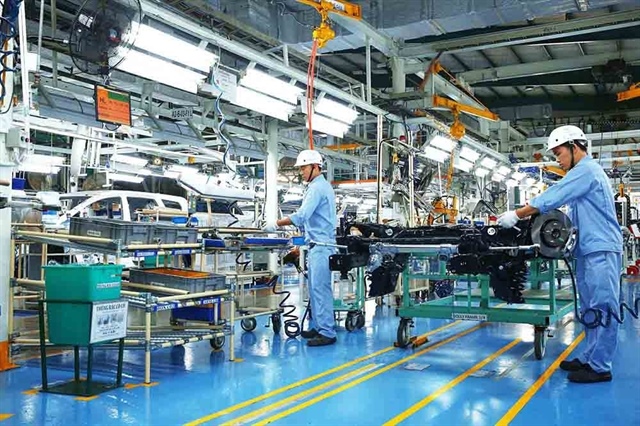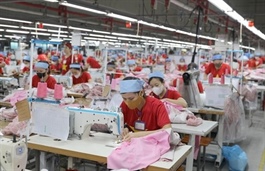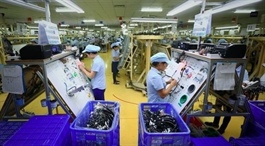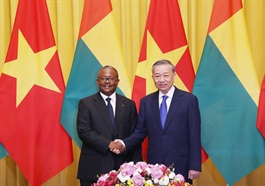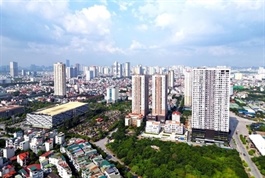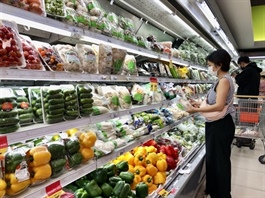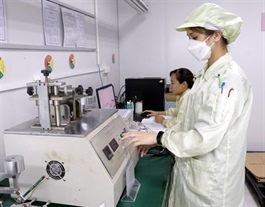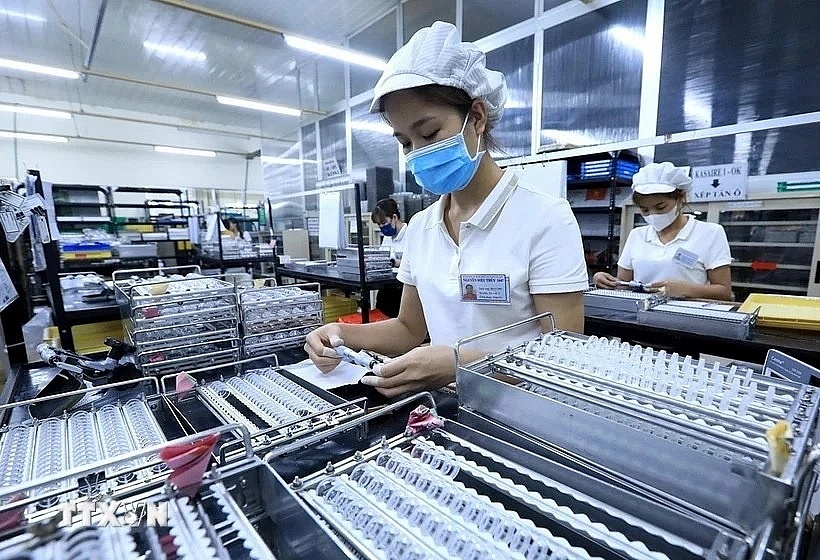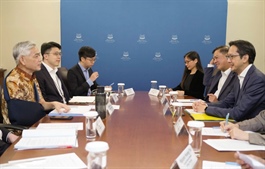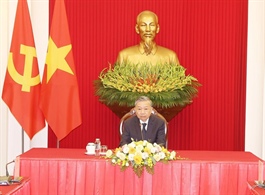Haiphong: hugely enticing for major funds from South Korean investors
Haiphong: hugely enticing for major funds from South Korean investors
Haiphong serves as a magnet to draw in investment influx from South Korean investors. Ko Tae Yeon, general director of Heesung Electronics Vietnam, explains how the northern port city can capitalise on its advantages in infrastructure, logistics, and more.

Transport, industrial, infrastructure, and logistics are just some of the areas of interest to South Korean financial backers in Haiphong. Closely following those are human resource factors, emphasising the importance of a well-trained and accessible workforce in influencing investment decisions.
Institutional quality holds moderate importance, indicating that the effectiveness of legal, regulatory, and governance frameworks is crucial, though not as critical as infrastructure and human resources in shaping foreign direct investment (FDI) inflows.
This analysis is part of my report on the enablers of FDI from South Korea into Haiphong. This research contributes to the broader understanding of FDI dynamics in Vietnam and provides valuable insights for enhancing the economic partnership between Haiphong and South Korea.
FDI is widely recognised as a crucial driver of economic growth, particularly in developing countries. It provides capital influxes, enhances technology transfer, boosts productivity, and fosters international economic integration. In Vietnam, FDI has been instrumental in transforming the economy, contributing to its rapid integration into the global market.
Haiphong, a key economic hub in northern Vietnam, has attracted significant FDI due to its strategic location, robust infrastructure, and favourable business environment, where South Korea has been one of the largest investors with heavy investments in manufacturing, electronics, and infrastructure sectors.
As the third-largest city in the country, Haiphong is a vital industrial and port city located on the coast of the Gulf of Tonkin. With its deepwater port, Haiphong serves as a critical gateway for trade and investment, particularly for Northeast Asian countries like South Korea. The city has been a major beneficiary of Vietnam’s economic reforms, attracting significant foreign investment, particularly from South Korea, which has emerged as one of the top sources of FDI in Haiphong.
South Korean investors have established numerous factories and industrial zones (IZs) in the city, contributing significantly to its industrial output and economic growth.
There is a need for a comprehensive analysis of the factors influencing capital from South Korea to Haiphong, given the rapid pace of economic globalisation and increasing competition for foreign investment. It is essential to identify the factors that make Haiphong an attractive destination for South Korean investors.
Despite the steady inflow of investments, there remains a need for a comprehensive analysis that considers both macroeconomic and microeconomic factors, as well as the unique characteristics of Haiphong as a destination for South Korean investors. Thus, this analysis is the result of the implementation of my report.
This research is necessary to fill the existing gaps in the literature and to provide actionable insights that can guide future investment policies and strategies. The primary purpose of this research is to examine and analyse the key factors affecting FDI inflows from South Korea into Haiphong. By identifying these factors, the study aims to provide a framework that can assist policymakers in creating a more conducive environment for attracting and sustaining South Korean investments in the port city.
Assessing complex factors
The central research question concerns the influential factors that shape the incentive for foreign direct investment in Haiphong. To tackle this inquiry, multiple criteria decision making (MCDM) arises as a suitable approach, frequently utilised to establish criteria priorities. The application of MCDM theory entails the determination of ranking outcomes for selected criteria and the assignment of weights. A variety of MCDM techniques are utilised in practical applications to allocate weights to various factors.
Among them, Fuzzy AHP stands out as a robust MCDM method due to its capacity to handle uncertainties and imprecise information in decision-making processes. The Fuzzy Analytic Hierarchy Process (Fuzzy AHP) was employed as the primary research method. Fuzzy AHP is a multi-criteria decision-making tool that allows for the incorporation of both quantitative and qualitative data, making it ideal for assessing complex factors influencing FDI.
The method emerges as a compelling choice in the specific context of FDI enablers exploration in dealing with uncertainties of fuzzy judgments and linguistic expressions of decision-makers. It enables decision-makers to express their preferences using linguistic terms, facilitating a more realistic representation of their perceptions.
To achieve the objectives of this study, the research involved interviews and surveys with 30 experts in the field, including policymakers, business leaders, and academics, to gather insights and data. Out of the 30 responses received, a careful review was conducted to ensure the quality and consistency of the provided data. It was identified that three responses exhibited inconsistencies in the information provided. To maintain the integrity and reliability of the dataset, a decision was made to omit these three responses from the analysis, and the total number of replies chosen is 27.
The decision to omit inappropriate data was guided by the principle of upholding the accuracy and coherence of the information gathered. This meticulous approach ensures that the analysis and insights derived from the questionnaire responses are robust and reflective of the genuine trends and perspectives within the diverse expert groups.
By consulting experts, an average pair-wise comparison matrix has been created based on the weight of each response to determine the weight assigned to each factor (see Table).
The calculation of the fuzzy geometric mean values of the factors involves the multiplication of matrix vectors that represent fuzzy integers. The weights calculated above represent the degree of significance assigned to each factor enabling FDI inflows from South Korean enterprises in Haiphong based on expert opinions and fuzzy logic calculations.
The highest weight is assigned to infrastructure factors including industrial, transport, and logistics ones, suggesting that experts believe that the development of infrastructure plays a significant role in attracting FDI to Haiphong. Human resources are the following most influential factors, indicating that the supply of workers and quality of workers is crucial in shaping FDI inflows in Haiphong.
The institutional quality has a moderate weight, suggesting that the effectiveness, efficiency, and reliability of a region’s legal, regulatory, and governance frameworks are considered important but not as decisive as infrastructure and human factors in influencing FDI decisions.
Other factors such as wage rate, consumer price index, political stability, and local supporting industries are positioned between the higher and lower weights, indicating their intermediate level of influence on FDI inflows. The moderate weight suggests that political considerations are important, but not as dominant as economic factors, in the decision-making process for FDI investors in Haiphong.
Key recommendations
The study’s findings offer clear guidance for policymakers and stakeholders in Haiphong to enhance the city’s attractiveness as a destination for South Korean investors. Based on the results concluded above, key recommendations to promote the attraction of South Korean capital influx into the city may include ensuring the availability of land within IZs and accelerating the development of the Southern Coastal Economic Zone to drive growth. Sustainable and environmentally friendly IZs should also be prioritised.
In transportation and logistics, it is crucial to develop a multimodal system that connects Haiphong seaport with the hinterland and to strategically plan logistics centres that offer diverse value-added services.
Human resource development is another critical area, where incentives should be provided to businesses for training and education, investments should be increased in educational infrastructure, and collaboration between businesses and training institutions should be strengthened.
Additionally, expanding South Korean language programmes and ensuring social housing supply are essential for attracting and retaining the workforce. Public administration efficiency should be improved through digital transformation, while policy mechanisms should be continuously refined to create a stable, transparent, and investor-friendly environment.
By implementing these solutions, Haiphong can strengthen its infrastructure, develop human resources, and improve institutional quality, thereby creating a more favourable environment for attracting capital from South Korea. This approach will enhance competitiveness and contribute to sustainable growth in the region.





